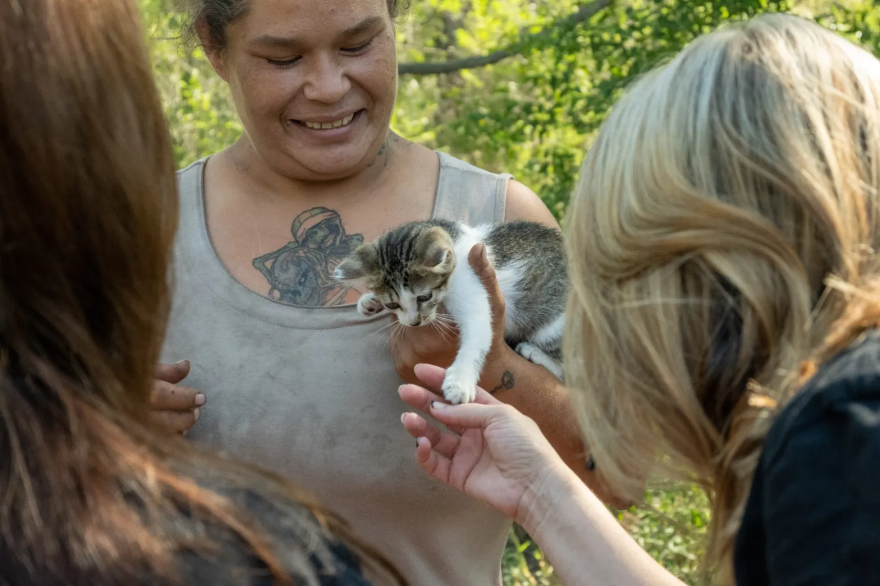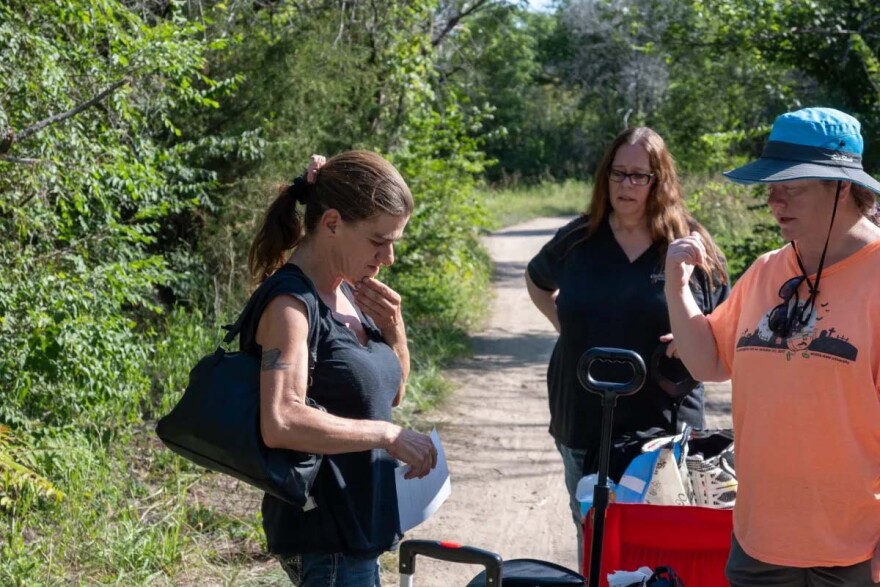Surviving often means taking cover.
During unforgiving heat, the official guidance urges us to stay indoors, drink plenty of water and let air conditioning to cool our skin. But some Wichitans didn’t have that option during the recent heat wave. For them, survival meant huddling in any existing shade, moving as little as possible – not breathing too heavily, waiting for the next sip of water – until the beating sun dipped below the horizon.
That’s the reality of living without permanent housing that The Journal witnessed while reporting on volunteers serving homeless campers across from a south Wichita park.
A massive August heat dome smashed records across the Plains, Midwest and South. In Wichita, temperatures soared above 100 degrees for seven consecutive days, according to the National Weather Service. Saturday, August 19 it was 111 degrees – the hottest temperature in the city in 11 years and only 3 degrees short of the all-time high temperature.
The following day, it peaked at 108 degrees.
With homeless Wichitans lacking refuge, other community members stepped in with water, food and kindness.
City officials, including Mayor Brandon Whipple, make efforts to support the homeless population during extreme heat through outreach and by providing access to water and air conditioned city buildings. But such help seemed far removed from the reality people experienced in encampments far from downtown.

Heat-related deaths tend to be rare in Wichita. But severe heat is the leading weather-related killer in the U.S., according to the Environmental Protection Agency, even though the agency says most heat-related deaths are preventable through outreach and intervention. The risks of heat-related deaths and illness are only expected to increase with unusually hot summers becoming more common, regularly bringing more frequent and intense heat waves like the one Wichita just experienced.
Homeless advocates and encampment residents say the city isn’t doing enough to protect vulnerable, unsheltered people during such events. Meanwhile, an increase in Wichita’s homeless population is testing the police department’s outreach efforts. Although the city is working alongside other groups to address the root causes of homelessness, it appears that few additional provisions are being made at City Hall to help the homeless survive future heat waves.
Just outside of Chapin Park, 9.a.m, Sunday
Five women and three teenage boys lug wagons of food, water and other supplies across a stretch of the Arkansas River hugging Chapin Park, a former south Wichita landfill that now hosts a dog park, an airfield for model plane enthusiasts and a mountain bike trail. The group then ventures into the woods to take essentials to homeless camps hidden beyond the trails.
Usually, the ringleaders of this outreach – Jonni Tennant and Kathy Bowles – set up in the parking lot of Chapin Park once a month at 1 p.m. Their “folks,” as they call them, know this schedule and leave camp to meet them. This month, with the sweltering temperatures, Tennant decided to have her group meet early and venture into the woods to minimize time in the heat for all parties.
“Can we talk real quick guys?” Tennant says before a group of eight, addressing new volunteers. “Sometimes homelessness isn’t very pretty. Pretty deplorable conditions sometimes. But we still try to be respectful, because it’s their home. Everybody down here deserves kindness. They’re used to people being mean and judgmental.”

Tennant, her daughter Shayla Duart and Bowles have been doing outreach with the homeless for about 20 years. They started by checking on those camped under bridges – with Duart in the passenger seat ready to call 911 in case anything went awry – and progressed to being among the most familiar faces to Wichita’s homeless population.
Early on this morning, the group found handmade signs asking guests to stay away.
Tennant and Bowles recognize the signature and call out. “Red and Debbie! It’s just Kathy and Jonni and some other folks with supplies! Rather than you guys going up there today. If you want to come on out.”
A moment of silence. Then, from behind a wall of foliage walks Debbie, loosely wrapped in a thin teal robe that falls a few inches above her knees. Her husband, Red, follows.
Tennant asks how she’s doing.
“We’re here,” she says. “It’s hot.”
Debbie told The Journal that she and Red have been homeless for almost six years. The couple, and their dog, Rocky, shelter under a scaffolding of thick trees and bushes. Their shelter offers good shade but doesn’t provide comfort during record-breaking heat.
“It seems like no matter what we tried yesterday, we couldn’t cool off,” she says, referring to the 111-degree heat.
For extreme temperatures – hot or cold – Debbie and Red limit their errands. They stay put, eat what they have and take solace in each other’s company. They say they have nowhere else to go, as there are no homeless resource centers within walking distance of Chapin Park.
“We don’t have a Lord’s Diner in this area,” Debbie says. “We don’t have (downtown Wichita’s) resources. Things are way out east or west or north. There’s no place down south.”

People like Tennant and Bowles provide the little generosity they receive. Most people “look at us like we crawled out from underneath a rock,” she says.
“You got to make your own way. Life doesn’t owe us a living. We’re very grateful and count our blessings.”
Farther north on the trail, two other Chapin area campers, Shonda and Shawna, find the volunteers and their wagons. Shawna carries a kitten someone recently gifted her. She named her Lamina – “animal” spelled backwards.
The group quickly ties off plastic bags filled with snacks and water for the women, including tins of cat food for Lamina.

The pair are neighbors. Shawna found an already settled-in Shonda after moving to Chapin Park last winter while “just trying to live.”
“It’s my first time I ever did anything like this. With my parents being gone and stuff it’s kind of what I’ve had to do,” Shawna says.
How does she survive a blazing hot day?
“I just lay there. I try to think of being on ice,” she says. “Don’t move. Try not to breathe too heavy.”
Complaints about, strains on services
Several campers claim that the Police Department’s Homeless Outreach Team(HOT) had not visited the woods outside Chapin Park in recent weeks, despite the dangerous temperatures.
Debbie says that officers only appear to “shove people over here,” suggesting that the outreach team routinely transports homeless people to Chapin Park’s established camps, hiding the homeless from sight.
Shonda and Shawna also say that the team is well aware of the number of people living off the trails, but only come to “drop off, evict or hunt people.”
“That’s the only time they show up,” Shonda says. “I don’t think they’ve ever been out here for any other reason. They’ve never brought supplies. The police don’t really do anything down here.”
Debbie also says that the last time she remembers the team servicing Chapin Park was around last Christmas, when temperatures dipped to 5 below zero.
“That was really, really bad,” Debbie says. “That was the only time HOT actually came out here and said ‘You guys really need to go somewhere else,’ and we did.” She says the outreach team did offer to transport them to HumanKind’s emergency winter shelter.

The Journal asked Officer Nate Schwiethale of the Homeless Outreach Team if it is routine for officers to move homeless people to Chapin Park. He says that’s not true, and that it is against the rules to transport a homeless person to a location beyond a shelter or a family or friend.
“We’re out there. We offer services to everyone,” Schwiethale says. “The only time we give people a ride is if they want a ride or need a ride, and then we want to be there for them and make them be successful.”
Schwiethale also thinks that the homeless population of Wichita may be bigger than the outreach team is currently equipped for.
In the last five years, the homeless population has increased over 20%, according to 2018 and 2023 point-in-time counts from the United Way of the Plains. Schwiethale, who trains other police departments on homeless outreach, said he developed an algorithm that suggests for every 125-150 homeless individuals in a community, there should be one outreach officer.
“Originally, four (officers) was enough,” Schwiethale says. “On any given day our homeless point-in-time count is about 700. Once we’ve hit that number, we’ve kind of hit the cusp where we probably need more (outreach) officers. But we’re also 100 police officers short for the department.”
Another frequent criticism is the lack of resources coming directly from the city of Wichita.
Whipple has posted online about the city having issues installing water refill stations and suggesting to those seeking air conditioning that they ride a city bus or visit libraries, community centers and museums.

The free, air-conditioned bus rides Whipple highlighted are unlikely to be taken advantage of by homeless people outside of downtown Wichita. The QLine only spans five miles from Delano to Lincoln Heights, far from scores of people who might be vulnerable to dangerous heat.
In response to The Journal’s inquiry, Whipple expanded on his online comments, saying that Public Works had “procurement issues with water stations” that delayed installation.
Currently, there are four public water stations budgeted. The first two will be operational by the end of September, according to Penny Feist, assistant director for public works. Those fountains are planned for Naftzger Park and Old Town Square and will be accessible 24/7.
“The locations of the next two are yet to be determined. Once the first two are operational, we will be monitoring trends to help us determine any changes that might be needed for the next two stations. There will be four stations operational by next summer,” Feist said in an email.
In the meantime, one very basic challenge looms large: How does someone without a home stay hydrated in scorching heat?
Some people, like Sarah Jane Sovereign, have taken the initiative to ensure Wichitans have access to free water. She started planting coolers with ice and water on Central Avenue after watching people walk to and from resource centers in downtown Wichita.
“Being on this stretch of road … you see the need. I’d see people walking and it’s 111 degrees outside. And so a couple times, I stop and offer rides and ask questions,” Sovereign says. “One gal told me that her and her people that she’s camping with under the underpass, they take turns walking to the Lord’s Diner and bringing back food for everybody.”

She said that Central Avenue is a main thoroughfare for many people in transition and people without transportation.
“The city told us the buses are cooling stations. People are still going to be waiting in the heat,” she said. “They’re going to be waiting where there’s no shelter, no access, no amenities. So I tried to get these coolers in a spot where maybe people can see it while they’re waiting and stay hydrated.”
Her initiative has expanded to a mutual aid operation with over 30 community hydration stations across central Wichita.

According to Schwiethale, the Homeless Outreach Team carries bottles of water to ensure people stay hydrated during hot temperatures.
People like Shawna and Shonda get creative too.
“We always get our own water,” Shonda says. “Sometimes the dog park. The sink in the bathroom fits a hose. Most of us go to Garvey Park for the spigots.”
Another homeless woman, who asked The Journal to withhold her name, said she cuts up hoses and attaches them to the faucets of public bathrooms.
“But they lock the bathrooms at night,” she says. “Some of us work all day and can’t get there (beforehand). The churches won’t help. And the gas station over here charges you for ice and water. It’s not much, but some people can’t even spare the change.”
The Journal asked Whipple if he thinks there should be a more targeted outreach for the homeless in severe heat and cold, specifically citing Chapin Park’s distance from many of the resources he mentioned.
“I think specific and individualized outreach to those living unhoused is the only real solution,” he says. “The HOT team dedicates their time to visiting camps across the city and offering them alternative resources if they’d like to relocate. They will help them secure transportation to somewhere cool and carry water and ice packs with them to hand out as they arrive at camps.”
Whipple also referred to HOT’s policy goals and Project HOPE, a city effort that provides a housing specialist and social worker for those experiencing homelessness. The initiative is funded by a $1 million Byrne Criminal Justice Innovation grant from the Department of Justice. Wichita’s grant runs through Sept. 30, according to its action plan.
Some advocates have expressed concern that Whipple’s suggestions for the homeless to use free museums or other city spaces for air-conditioning is unrealistic. Tennant says she’s not sure that a homeless person would feel welcome in the Wichita Art Museum, for example.
In addressing these concerns, Whipple says that city staff working in such spaces often find that the homeless who come in do so because they don’t want to go to a place designated for homeless services. They feel safer in a city space, he says.
“It is a negative stereotype that all people living unhoused are disruptive or unable to enter a public space without being disruptive,” Whipple says. “However, while they are in a city facility, our staff can discuss options available to them, including opportunities for shelter, housing, mental health and addiction services.”
‘Taking action’
In late August, the city passed its 2024-25 annual budget. In a social media post, the city said that $100,000 was approved for more watering stations across the city. The detail is not specifically outlined in the city’s online document under “homelessness assistance” or under the public works pages, but Feist confirmed that $135,000 was added to Wichita’s Capital Improvement Plan for “water filling stations and other public amenities.”
The city’s projected numbers for homeless assistance also remain the same: $319,966 for building/equipment charges, $59,404 for other contractual, and $3,366 for city admin charges. Nothing under “homelessness assistance” specifies measures to address health emergencies such as extreme heat.
Whipple says that, instead of designating cooling stations that are only available during heat emergencies, the city is working on plans to “provide as many opportunities as possible for people to stay cool.”

“We are also investing in services to help treat the root causes of homelessness – not just the symptoms,” Whipple says. “Solving homelessness isn’t just a government issue – it takes a wide coalition of providers, nonprofits, businesses and community support to solve big problems. Instead of talking about the problem, the city of Wichita is taking action.”
Schwiethale said Wichita has other gaps to address in the fight to minimize homelessness: a lack of shelter space and some people’s hesitancy to stay in one.
“There’s gaps in the community. No. 1 is female shelters,” he said, referring to the Salvation Army’s recent closure of an emergency shelter for women. Another is that many homeless refuse shelters due to security concerns.
“You’re sleeping next to someone you don’t know, and there’s like 100 people,” he says. “People don’t feel safe doing that. Or they get their stuff stolen. So they don’t want to use the shelter.”
He adds that the city is expected to reach a functional zero goal for its unhoused veteran population by the end of next year – meaning that the number of people experiencing homelessness won’t exceed the community’s capacity to move people into permanent housing.

For Tennant, the city’s funding allocations are a delicate subject.
“We have a $6 million dollar pickleball court … but nobody comes to check on these people. It’s irritating,” Tennant says. “Our city’s focus has changed to bigger businesses, bigger tourist attractions, so they bring (the homeless) out of downtown. Otherwise, it makes them look bad.”
Sally Stang, the director of Wichita’s Housing and Community Services, said last year the city began considering a $5.5 million facility to address homelessness, including a shelter, affordable housing units and a center with supportive services.
With the plan, Schwiethale wants to advocate for non-congregate shelters, which he says provide individuals with a private space where one can have “your own bathroom, lock the door and feel safe.”
“There’s so many things in the cogs that are going to be a huge improvement on our HOT team and homelessness in general that I haven’t seen before in my entire 20 years on the department,” he said.
The plan, funded with money from the American Rescue Plan Act, was recently approved a development partner to organize the allocation of funds, research the best location for the future center and find social service partners.
Tennant says she’s tired of task forces and proposals with great ideas but little follow-through. She sees the consequence of policy failure.
“I guess they don’t really realize that people die in the summer and winter,” she says. “There’s been plenty of times that Kathy and I have come during the winter to check on people.
“We open up those tents just praying that nobody’s dead in there.”
Copyright 2023 KMUW | NPR for Wichita. To see more, visit KMUW | NPR for Wichita. 9(MDA4OTAxNzAzMDEzMjc0MTc2MzA5ZDZlMw004))







